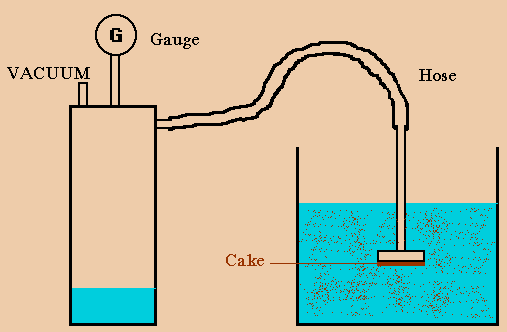Filtration is defined as the separation of insoluble solids from a liquid by forcing a portion of the liquid through a porous medium by a pressure differential, while the solids are trapped on the surface or in the depth of medium. The two main methods that exist to create the required pressure differential are:
- Application of vacuum – vacuum filtration
- Application of high pressure to the slurry and squeezing the solids – pressure filtration
While vacuum filtration is adopted in a large variety of mineral processing industries, pressure filtration would be preferred where:
- The liquid is either too viscous
- The liquid is very close to the boiling point
- Solids are so fine and filter so poorly, or feed concentration is so low that a discharge cake cannot economically be formed, and a pre-coat filter cannot be considered for other reasons.
Leaf Filter Testing
The “leaf test” represents a small section of a continuous filter incorporating typical filter medium support and filtrate drainage. When used with techniques properly simulating the continuous filter, it can give results adequate for sizing production filters and predicting performance or determining the need for pilot testing.
Sample Size – Generally 15-20 liters of representative slurry.
Before testing, a representative portion containing sufficient solids to be meaningful should be taken for solids concentration determination. The concentration is found by weighing the sample, filtering on a Buchner funnel fitted with two No. 1 Whatman papers, washing if necessary, drying at a suitable temperature and determine the net dry weight. The solids concentration expressed in per cent is dry net weight x 100 divided by sample weight.
The test data format (missing) calls for the minimum of essential data and calculated rates. The feed % solids analysis on the bulk sample being tested is the “feed basis”. By dividing the cake dry weight by the sum of cake wet weight (vol x specific gravity), the “product basis” feed % solids is determined. A significant difference between the two is evidence that the system is not at equilibrium due to filter thickening, inadequate or excessive agitation, or excessive loss of solids to the filtrate.
The actual vacuum throughout a test should be controlled and observed since this is a major factor in performance and sizing.
Reasonably complete information is needed on the material to be filtered. Ex: slurry identification, specific gravity, pH, % solids, temperature, solids identification, particle size, specific gravity, liquor identification and specific gravity.
Further slurry information desirable is: its physical nature; plant upstream process and possible variations to meet filtration objectives; the solids settling tendency and hence gravity thickening possibilities; whether solids are naturally flocculated or amenable to flocculation; temperature variations; flexibility for pH adjustment; ageing effect inherent in the process, particle shape and variations with size; variations of the kind solids with size (ex. % ash may be higher in fine particles); porosity of individual particles; solubility of filter cake; inherent water of hydration; impurities; temperature of permitted oven drying. Other useful liquor information is: soluble solids content and their relation to saturation; viscosity; surface tension, vapour pressure variation with temperature; compatibility with flocculants.
Measure and record the filtrate volume. When the cake has a mushroom shape requiring exclusion of the trim weight, the same proportion of filtrate must also be deducted. Comment on the quality of the filtrate, testing for solids content when pertinent. Measure and record the specific gravity and pH of filtrate.
In conjunction with any of the discharge methods, it is important to record observations regarding cake nature, any abnormality, cake release from the cloth, and condition of the cloth.
Laboratory Pressure Filtration
The laboratory batch pressure filters installed in most lab serve the primary purpose of dewatering solid-fluid suspensions and have not been designed for the performance of specific pressure filter tests. However, by maintaining operating parameters constant e.g. slurry % solids, overall pressure applied and overall filtration time, it is possible to obtain comparative filterability data.
Steps for Leaf Testing
- Stir the slurry with a spoon or spatula or an agitator to obtain a uniform suspension of the solids.
- Turn on the vacuum source and adjust the test vacuum while pinching off the hose to the test leaf.
- Submerge the leaf in the slurry, open the hose and simultaneously start the timer. Stir the slurry as needed during form time.
- At the end of planned form-time rotate the leaf up and out of the slurry just as a filter section and dry. During the dry time slowly rotate the leaf, tilting it from it horizontal plane to half drain the leaf. Dry for the planned time. Note the time of any cake cracking.
- Turn off the vacuum, quickly remove the tubing from the flask to break the vacuum on the leaf. Elevate the leaf and drain remaining filtrate to the flask. If necessary to facilitate draining, lift a portion of the cake off the cloth.
- Explore the best method of cake discharge as detailed under 11 below. If cake is mushroom-shaped, extending beyond the 0.1 ft2 cloth area, trim off and separately weigh the trim. Note: this correction is approximate.
- Transfer the 0.1 ft2 cake to a tared dish. Again allow leaf to drain residual filtrate to the flask. Set the leaf aside.
- Measure and record cake thickness and any variations.
- Weigh the dish and contents. Record the gross wet weight. Put the dish in an oven at 1050C or lower temperature if necessary. Dry overnight, then record the gross dry weight.
Alternatively, use drying lights until a constant dry weight of the filter cake is obtained.
